When the new vaccines against COVID hit the market there was one thing that was made clear, the vaccines protect against serious cases of COVID including hospitalizations and deaths.
With time it became clear that the vaccines don't reduce infections and while, in many cases, they actually increase infections, vaccine advocates continue to claim that the vaccine prevents hospitalization and death.
The original studies that were conducted in order to get regulatory approval did not examine all-cause mortality, rather it looked at mortality from COVID - since that was what the vaccines were designed to reduce. And in fact, the vaccines did show a significant reduction in deaths from COVID.
But what about all-cause mortality? Could it be that the vaccines reduced deaths from COVID but increase deaths from other causes? This question led to much speculation and was reinforced by careful examination of the report from Pfizer.
The report showed that after 8 months of study, there were 21 deaths in the vaccinated group and 17 in the unvaccinated group. Indeed, there were more deaths from the vaccine group than there were in the placebo group. Not by much, just about a 22% relative increase, but since this was just below being statistically significant, and the report did not consider the deaths to be caused by the vaccine - the case was closed.
In April 2022, a study made available as a preprint in The Lancet was comparing the mRNA vaccines (Pfizer and Moderna) to the adenovirus-vector (AstraZeneca and Johnson & Johnson) to examine how they differ regarding adverse reactions. In the introduction, the paper states, “it has now been established in numerous studies, [that] vaccines may have completely unexpected effects on overall mortality.”
And that this was particularly concerning since “The placebo-controlled RCTs of COVID-19 vaccines were halted rapidly due to clear [positive] effects on COVID-19 infections.”
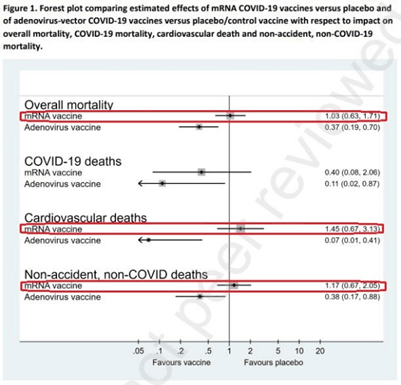
Source: https://papers.ssrn.com/sol3/papers.cfm?abstract_id=4072489
The data showed that participants who had the mRNA vaccine had higher cardiovascular deaths, non-accidental deaths, and all-cause deaths compared to the placebo groups after examining nine randomized-controlled trials (RCTs).
If not for the lives the vaccines saved in COVID deaths, the mRNA vaccines would have killed more people than they saved. This is important since many people taking the mRNA vaccines are at low risk of dying from COVID.
It was noted in the conclusion that most of the wealthier countries chose the mRNA vaccines, which were connected to higher mortality. The authors concluded by saying that “this could turn out to be a very costly decision, both economically and health-wise.”
See an interview with the lead researcher, Prof. Christine Stabell-Benn:
Real-world data:
Can this observation that the mRNA vaccines potentially cause more deaths than they save be seen in real-world data?
There have been a few observational studies that examined the issue and found that vaccination was associated with reduced overall mortality, so there was nothing to fear.
These studies were conducted in the first six months of the vaccination campaign, but it seems things have changed over time.
The Netherlands
One study in the Netherlands looked at how much the COVID vaccination affected overall mortality. This is an important question since vaccination may reduce 'COVID deaths', a term that has an imprecise and overly broad definition, but it may also increase death from other causes. So looking at mortality from all causes can help give a clearer picture.
The study charted excess deaths, COVID deaths, vaccinations, and at the bottom the corresponding z-score.
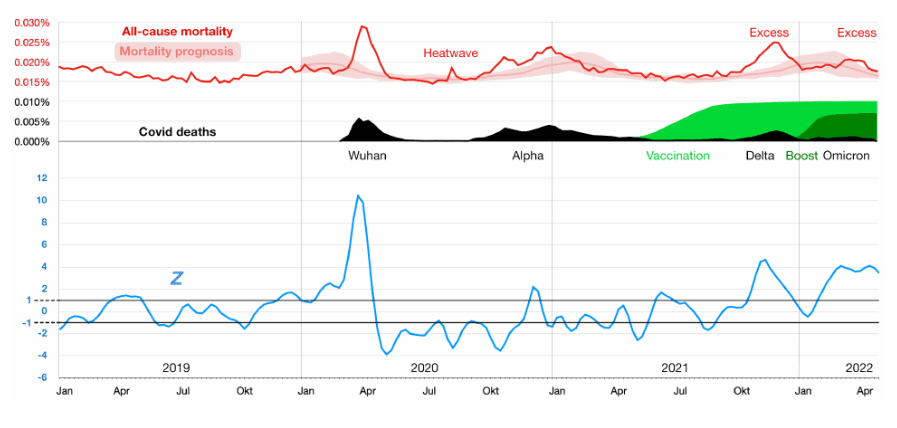
The study's authors stated that "we could not observe a mortality-reducing effect of vaccination in Dutch municipalities after vaccination and booster campaigns. We did find a 4-sigma-significant mortality-enhancing effect during the two periods of high unexplained excess mortality.
Meaning, that the vaccination campaign was not associated with a reduction in overall mortality, but instead was associated with a significant rise in mortality beyond what was attributed to "COVID deaths" (see the two periods labelled "excess" on the right side of the above graph)
The study shows that the COVID vaccines failed at saving lives and may have even caused more deaths. The study concludes, "Our main result remains alarming and calls for more research on the effect of current covid vaccines on all-cause mortality."
Cyprus
The Netherlands' experience is not unique. A study of Cyprus' all-cause mortality found the same thing.
Based on our data analysis, we observed a substantial increase of 9.7% in all-cause mortality in Cyprus in 2021 compared to 2020, with an overall mortality increase of 16.5% in 2021 compared to the mean mortality of the previous five years. Particularly, we documented a sharp increase over the third and fourth quarters of the year 2021.
The study concludes,
the substantial increase in mortality in Cyprus in 2021 is not entirely explained by COVID-19 deaths and is parallel to the concurrent vaccination campaign. This concerning observation should be comprehensively investigated by the National and European public health authorities to identify and address the underlying causes.
Australia
Australia provides an interesting situation since it vaccinated about 75% of its population months before its first major wave of COVID. That the vaccine did not prevent the wave, nor the subsequent deaths that were attributed to COVID, should not be overlooked.
The Australian data below show that all-cause mortality was 9% higher than baseline according to the Australian Bureau of Statistics following the vaccination campaign, but before the COVID wave that followed.
The elevated all-cause mortality increased through the summer months peaking at 23% during the COVID wave in Jan 2021 (summer in Australia). Despite the reduction of COVID infections in April, all-cause mortality was still 14% above baseline until May 2022 – the last month with available data.

United Kingdom
The Expose presented data from the UK’s Office of National Statistics comparing all-cause mortality from the start of the vaccination campaign in January 2021 to January 2022 and found a surprising difference.

Source: https://dailyexpose.uk/2022/04/20/analysis-gov-data-finds-covid-vaccination-increases-risk-death/
Vaccinated individuals in January 2021 were dramatically more protected against all causes of death compared to the unvaccinated. But by January 2022, vaccinated individuals who did not receive a booster were dramatically worse off compared to the unvaccinated.
Perhaps it’s just a statistical anomaly in January’s data. So The Expose charted the data over the course of 2021 to see when this change occurred.

Source: https://dailyexpose.uk/2022/04/20/analysis-gov-data-finds-covid-vaccination-increases-risk-death/
According to the above graph, during the months of October and November the picture started to change – unless the vaccinated received a booster they would be more likely to die than if they took no vaccine at all, and the situation was much worse for those injected with just one dose (red lines).
While it makes sense that a booster shot should improve the risk of death, what is troubling is that the two-dose vaccine was associated with more mortality than no vaccine at all.
This may be a good reason to take a booster, but it’s also concerning that hundreds of millions of people’s lives are potentially at risk just because they got vaccinated.
Before drawing a conclusion it’s imperative that the analysis is broken down by age range since that’s a key indicator of COVID mortality and of vaccination uptake. If age is ignored, it could be that the unvaccinated are dying less because they tend to be younger, and younger people generally have much lower mortality.
The following graphs show all-cause mortality per 100K across each age group:

Source: https://dailyexpose.uk/2022/04/20/analysis-gov-data-finds-covid-vaccination-increases-risk-death/
Across every age group, without exception by January 2022 the double vaccinated died more than the unvaccinated.
Germany
Just last week a new study looked at the excess mortality in Germany since the start of the pandemic. It started by explaining the need for such a study. As mentioned above the designation of "COVID death" is very ambiguous, however, the study cites autopsies showing that about 86% of COVID deaths actually died of COVID. The rest were from other causes.
"For the pandemic years 2020 and 2021, it is clear that the number of deaths has been influenced directly and indirectly by COVID-19. First, clearly, there has been a serious number of COVID-19 deaths, either as the only reason for death or in combination with several other causes. . . . Second, the vaccination campaign which started in 2021 should be visible in reduced excess mortality, or even better as a mortality deficit."
Here's what the study found.
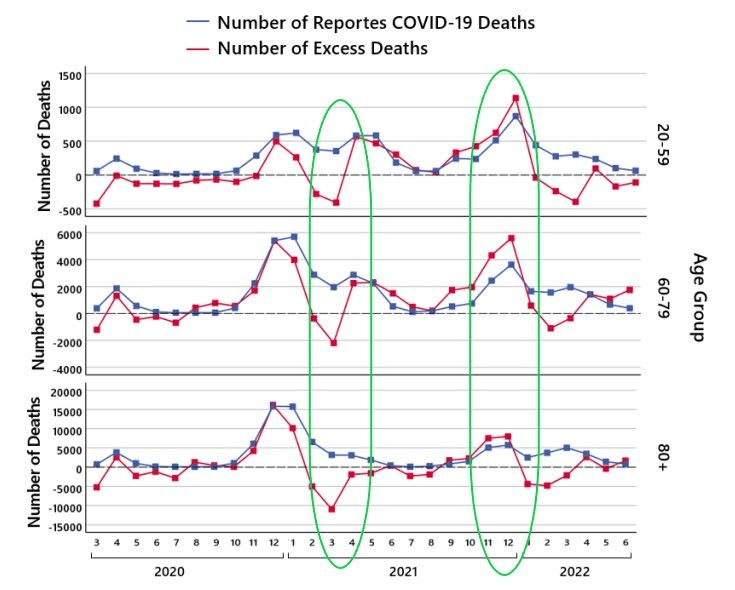
Excess deaths during the months of March and April of 2021 increased dramatically without much accompanying "COVID deaths". What caused this increase? Later in October - December there is an increase in both excess mortality and "COVID deaths" however it is the first time since the start of the pandemic that excess deaths are consistently higher than "COVID deaths".
In nearly all months, across all ages, the blue lines ("COVID deaths") are the same or equal to the red lines (excess deaths). That changed in the fall of 2021. The same question remains – what caused the jump in excess deaths to even surpass "COVID deaths"?
The paper further points out that "maybe [the] most surprising fact is that the second year produces in all age groups a significant mortality increase, which is in sharp contrast to the expectation that the vaccination should decrease the number of COVID-19 deaths. The only exception is the last age group (80, ∞), wherein the first year a large number of excess deaths was observed."
What happened in the spring and then the fall of 2021?
The study looked at one of the obvious events that took place in 2021 – the mass COVID vaccination campaign. In the graph below there are three important observations.
The first is that excess mortality in January dropped dramatically before mass vaccination. The second observation is that excess mortality rose dramatically at the same time as the first dose was given. The final observation is that it happened again with the third dose in October-December.
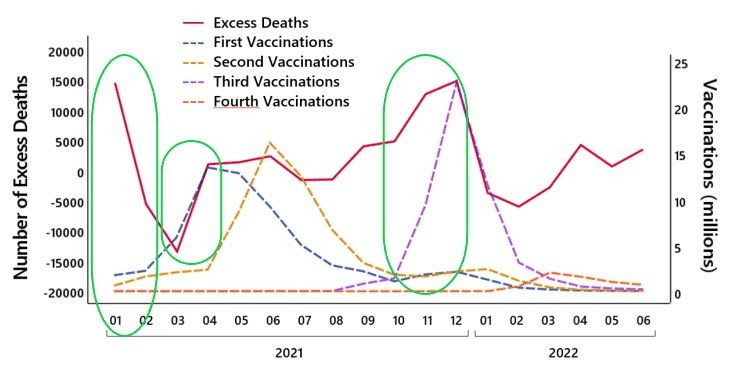
"The following graph illustrates that the deviation of the observed mortality from the expected mortality is not uniform over the different age groups, and in particular, the structure changes from 2020 to 2021. A closer look reveals that the excess mortality observed in 2021 is almost entirely due to an above-average increase in deaths in the age groups between 15 and 79. The highest values are reached in the age group 40-49, where an increase in the number of deaths is observed that is nine percent higher than the expected values."
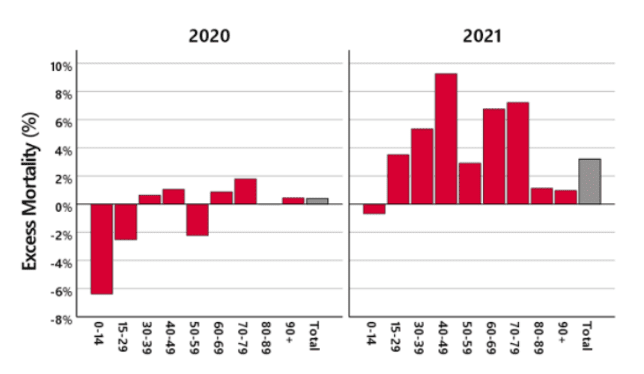
This paper used a "state-of-the-art method of actuarial science" to set the expected all-cause mortality in 2020 and 2021 and see if there is a difference between what was expected and what actually occurred.
The paper concludes that, "In 2020, the observed number of deaths was close to the expected number with respect to the empirical standard deviation. By contrast, in 2021, the observed number of deaths was two empirical standard deviations above the expected number."
To put that in context, "A bound of 2.24 times the standard deviation leads to a 2.5% confidence interval, which roughly speaking means that this event occurs 2-3 times every hundred years."
Put differently, 97.5% of the time we would expect a lower number of deaths.
The discussion surrounding the cause of increased mortality since the launch of the COVID vaccine is unlikely to end soon. Mainstream observers might point to long-COVID which somehow causes death months after infection. One thing is clear, the vaccines have not reduced excess mortality as mainstream experts asserted it would.
Email questions or comments to frontlinepedia@aflds.org
